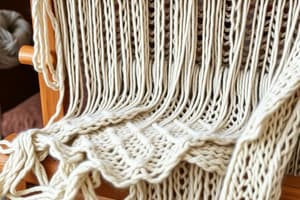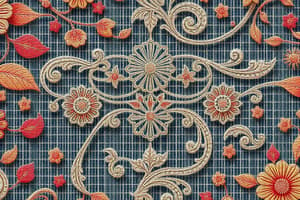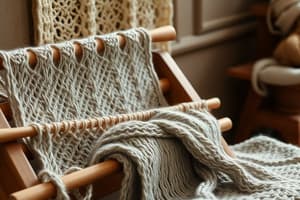Podcast
Questions and Answers
In Tagalog, knitting is referred to as "pagbababad," "pananahi," or most commonly, "______."
In Tagalog, knitting is referred to as "pagbababad," "pananahi," or most commonly, "______."
pag-aahit
Knitting is believed to have originated around the ______ centuries AD.
Knitting is believed to have originated around the ______ centuries AD.
1st to 5th
The earliest evidence of knitting comes from the ______, particularly Egypt.
The earliest evidence of knitting comes from the ______, particularly Egypt.
Middle East
Knitted socks dating back to the 11th century have been discovered in ______.
Knitted socks dating back to the 11th century have been discovered in ______.
The invention of the Stocking Frame by William Lee helped ______ the process of knitting.
The invention of the Stocking Frame by William Lee helped ______ the process of knitting.
William Lee, an English inventor, was a ______ by profession.
William Lee, an English inventor, was a ______ by profession.
Queen Elizabeth I refused to grant William Lee a patent for his knitting machine because of concerns about its impact on ______.
Queen Elizabeth I refused to grant William Lee a patent for his knitting machine because of concerns about its impact on ______.
During the Victorian Era, knitting became popular not just as a household activity, but also in the ______ industry.
During the Victorian Era, knitting became popular not just as a household activity, but also in the ______ industry.
During the Victorian era, many women participated in knitting for charitable causes, especially during war like the ______ War.
During the Victorian era, many women participated in knitting for charitable causes, especially during war like the ______ War.
During wartime, knitting became an essential activity, especially during ______ and World War II.
During wartime, knitting became an essential activity, especially during ______ and World War II.
Soldiers needed items like socks, gloves, and scarves to stay warm and protected from extreme conditions of ______.
Soldiers needed items like socks, gloves, and scarves to stay warm and protected from extreme conditions of ______.
Organizations like the ______ organized knitting drives to collect knitted products for soldiers and those in need.
Organizations like the ______ organized knitting drives to collect knitted products for soldiers and those in need.
Knitting became a way of showing ______ for soldiers on the war front.
Knitting became a way of showing ______ for soldiers on the war front.
Women felt pride and contributed to their country through their hands by ______.
Women felt pride and contributed to their country through their hands by ______.
Wool was often prioritized for military use which meant women at home had to be resourceful with limited ______.
Wool was often prioritized for military use which meant women at home had to be resourceful with limited ______.
Besides being useful, knitting became a hobby and creative ______.
Besides being useful, knitting became a hobby and creative ______.
Social media platforms like ______, YouTube, and Ravelry have helped build large online knitting communities.
Social media platforms like ______, YouTube, and Ravelry have helped build large online knitting communities.
The trend of ______ involves reusing old clothes or yarn to create new products.
The trend of ______ involves reusing old clothes or yarn to create new products.
The concept of ______ influences knitting, with people making their own clothes to reduce their environmental impact.
The concept of ______ influences knitting, with people making their own clothes to reduce their environmental impact.
Knitting is known for its ______ on mental health, helping to reduce stress and anxiety.
Knitting is known for its ______ on mental health, helping to reduce stress and anxiety.
Many use knitting to ______ and induce a sense of peace.
Many use knitting to ______ and induce a sense of peace.
In some cultures, knitting is associated with specific ______ or life events.
In some cultures, knitting is associated with specific ______ or life events.
In some indigenous cultures, knitted garments might be created for ______ or to mark significant milestones.
In some indigenous cultures, knitted garments might be created for ______ or to mark significant milestones.
In Norwegian and Swedish cultures, specific patterns were tied to ______ or heritage.
In Norwegian and Swedish cultures, specific patterns were tied to ______ or heritage.
Flashcards
Upcycling
Upcycling
Using old clothing or yarn to make new products.
Slow fashion
Slow fashion
Creating clothes and fashion items slowly and sustainably, prioritizing quality and ethical practices.
Ceremonial Use of Knitting
Ceremonial Use of Knitting
Knitting for its symbolic meaning and association with rituals, life events, and cultural identity.
Symbolic Clothing
Symbolic Clothing
Signup and view all the flashcards
Knitting and Mental Health
Knitting and Mental Health
Signup and view all the flashcards
Online Knitting Communities
Online Knitting Communities
Signup and view all the flashcards
Cultural preservation through knitting
Cultural preservation through knitting
Signup and view all the flashcards
Knitting for economic gain
Knitting for economic gain
Signup and view all the flashcards
What is knitting?
What is knitting?
Signup and view all the flashcards
When did knitting start?
When did knitting start?
Signup and view all the flashcards
Where did knitting originate?
Where did knitting originate?
Signup and view all the flashcards
How did the Stocking Frame impact knitting?
How did the Stocking Frame impact knitting?
Signup and view all the flashcards
What was the reaction to Lee's Stocking Frame?
What was the reaction to Lee's Stocking Frame?
Signup and view all the flashcards
What was the Victorian Era's significance for knitting?
What was the Victorian Era's significance for knitting?
Signup and view all the flashcards
What were some aspects of knitting in the Victorian Era?
What were some aspects of knitting in the Victorian Era?
Signup and view all the flashcards
How were knitting techniques documented in the Victorian Era?
How were knitting techniques documented in the Victorian Era?
Signup and view all the flashcards
Knitting During Wartime
Knitting During Wartime
Signup and view all the flashcards
Knitting Drives
Knitting Drives
Signup and view all the flashcards
Knitting as a Symbol of Unity
Knitting as a Symbol of Unity
Signup and view all the flashcards
Resourcefulness in Wartime Knitting
Resourcefulness in Wartime Knitting
Signup and view all the flashcards
Practical Necessity of Knitting for Soldiers
Practical Necessity of Knitting for Soldiers
Signup and view all the flashcards
Knitting as a Hobby
Knitting as a Hobby
Signup and view all the flashcards
Knitting in the Crimean War
Knitting in the Crimean War
Signup and view all the flashcards
Knitting in WWI & WWII
Knitting in WWI & WWII
Signup and view all the flashcards
Study Notes
What is Knitting?
- Knitting, in Tagalog, is called "pagbababad" or "pananahi".
- A more common Tagalog term is "pag-aahit" or "pagkakalikat".
- Knitting involves intertwining threads using needles to create fabric.
- Examples of knitted items include sweaters, scarves, and other garments.
When Did Knitting Start?
- Knitting likely originated between the 1st and 5th centuries AD.
- Exact beginnings are unclear.
- Early evidence comes from the Middle East, particularly Egypt, where knitted socks from the 11th century have been unearthed.
- The craft likely spread throughout Europe and the Mediterranean to be used for garments and decoration.
Knitting in the 16th Century
- Knitting became more common in Europe.
- Techniques were refined further.
- William Lee, an Englishman, invented the stocking frame in the 16th century.
- This invention made the knitting process more industrial and accessible to a wider population.
Victorian Era Knitting
- The Victorian Era (1837-1901) was an important period for knitting.
- Knitting expanded beyond a household activity to be included in the textile industry.
- The craft was affected by social, cultural, and technological factors.
- Aspects of Victorian-era knitting included domestic crafts, fashion, industrialization, patterns, publications (like The Lady's Self-Instructor), and charitable practices.
Wartime Knitting
- Knitting was vital during World Wars I and II.
- Soldiers needed warm clothing like socks, gloves, and sweaters.
- Knitting became a crucial activity for supporting the troops and providing comfort.
- Organizations like the Red Cross promoted knitting drives to encourage and support soldiers and communities.
Modern Knitting
- Knitting now utilizes social media for community building, like Instagram, YouTube, or Ravelry.
- There is a surge in eco-conscious knitting with sustainable options like up-cycling and slow fashion.
- Knitters participate in online communities to share, learn, and connect.
- Knitting has mental health benefits.
Symbolic and Ritualistic Knitting
- Knitting is more than a craft in specific cultures.
- It is symbolic of storytelling, heritage, folklore, and expressions of identity.
- Oral storytelling passed down with knitting patterns and historical context.
- Patterns represent family history and/or cultural identity.
Studying That Suits You
Use AI to generate personalized quizzes and flashcards to suit your learning preferences.





